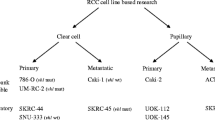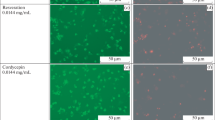Summary
MTT staining procedures have been used in chemosensitivity testing of established cell lines of human and other sources as well as of human leukaemias, but only limited information on its application in primary solid human tumors is presently available. We have evaluated MTT staining in primary human Renal Cell Carcinomas (RCCs), studied various factors interfering with the optimal use, and finally applied it in subsequent chemosensitivity testing. The method depends on the conversion of a water-soluble tetrazolium salt (MTT) to a purple colored formazan precipitate, a reaction effected by enzymes active only in living cells. Single cell suspensions of RCCs were obtained either by enzymatic dispersion or by mechanical dissagregation, filtered through gauze, and purified by Ficoll density centrifugation. Tests were carried out in 96-well microculture plates. 104 viable tumor cells per well at 4 h incubation time with 20 μg MTT/100 μl total medium volume yielded best results. Formazan crystals were dissolved with DMSO, and the plates were immediately measured on a microculture plate reader at 540 nm. Under these criteria, linearity of the system could be demonstrated. For chemosensitivity testing, cells were continuously exposed to a number of drugs prior to the MTT staining procedure. Reproducibility of results was assessed and confirmed by culturing RCCs in flasks additionally, resubmitting them after 1, 2, and 4 weeks to the MTT assay. We conclude that the semiautomated MTT assay offers a valid, rapid, reliable and simple method to determine the degree of chemoresistance in primary human RCCs.
Similar content being viewed by others
References
Alley MC, Lieber MM (1984) Improved optical density of colony enlargement and drug cytotoxicity in primary soft agar cultures of human solid tumour cells. Br J Cancer 49:225
Alley MC, Scudiero DA, Monks A, Hursey ML, Czerwinski MJ, Fine DL, Abbott BJ, Mayo JG, Shoemaker RH, Boyd MR (1988) Feasibility of drug screening with panels of human tumor cell lines using a microculture tetrazolium assay. Cancer Res 48:589
Carmichael J, De Graff WG, Gazdar AF, Minna JD, Mitchell JB (1987) Evaluation of a tetrazolium based semiautomated colorimetric assay: assessment of chemosensitivity testing. Cancer Res 47:936
Carmichael J, De Graff WG, Gazdar AF, Minna JD, Mitchell JB (1987) Evaluation of a tetrazolium based semiautomated colorimetric assay: assessment of radiosensitivity. Cancer Res 47:943
Coles SPC (1986) Rapid chemosensitivity testing of human lung tumor cell lines. Cancer Chemother Pharmacol 17:259
Courtenay VD, Mills J (1978) An in vitro colony assay for human tumors grown in immune-suppressed mice and treated in vivo with cytotoxic agents. Br J Cancer 37:261
Denizot F, Lang R (1986) Rapid colorimetric assay for cell growth and survival. Modifications to the tetrazolium dye procedure giving improved sensitivity and reliability. J Immunol Methods 89:271
Finlay GJ, Baguley BC (1984) A semiautomated microculture method for investigating growth inhibitory effects of cytotoxic compounds on exponentially growing carcinoma cells. Anal Biochem 139:272
Fraser LB, Spitzer G, Ajani JA, Brock WA, Lukeman J, Pathak S, Tomasovic B, Thielvoldt D, Williams M, Vines A, Tofilon P (1986) Drug and radiation sensitivity measurements of successful primary monolayer culturing of human tumor cells using cell-adhesive matrix and supplemented medium. Cancer Res 46:1263
Hamburger AW, Salmon SE (1977) Primary bioassay of human tumor stem cells. Science 197:461
Hill BT (1983) Use of continuous human tumor cell lines to evaluate drugs by clonogenic assays. In: Dendy PP, Hill BT (eds) Human tumor drug sensitivity testing in vitro. Academic Press, New York, p 129
Klebe RJ, (1984) Rapid cloning of mammalian cells with honey-comb cloning plates and nonlethal vital stains. In Vitro 20:127
Kondo T, Ohkubo K (1967) In vitro test for prediction of side effects of carcinostatic agents. Gann 58:349
Lieber MM (1984) Soft agar colony formation assay for in vitro chemotherapy sensitivity testing of human renal cell carcinoma: Mayo clinic experience. J Urol 131:391
Mickisch G, Volm M, Tschada R, Potempa J, Alken P (1989) Chemoresistenz des primären Nierenzellkarzinoms im in-vitro Kurzzeittest und ihre Durchbrechung mit Verapamil. Aktuel Urol 20:81
Mosmann T (1983) Rapid colorimetric assay for cellular growth and survival: application to proliferation and cytotoxicity assays J Immunol Methods 65:55
Scudiero DA, Shoemaker RH, Paull KD, Monks A, Tierney S, Nofziger TH, Currens MJ, Seniff D, Boyd MR (1988) Evaluation of a soluble tetrazolium/formazan assay for cell growth and drug sensitivity in culture using human and other tumor cell lines. Cancer Res 48:4827
Selby P, Buick RN, Tannock I (1983) A critical appraisal of the “human tumor stem cell assay”. N Engl J Med 308:129
Slater TF, Sawyer B, Sträuli UD (1963) Studies on succinate-tetrazolium reductase systems: points of coupling of four different tetrazolium salts. Biochem Biophys Acta 77:383
Torti FM (1983) Treatment of metastatic renal cell carcinoma. In: Torti FM (ed) Urologic cancer: chemotherapeutic principles and management. Springer, Berlin Heidelberg New York, p 123
Twentyman PR (1980) Experimental chemotherapy studies: intercomparison of assays. Br J Cancer 41:279
Twentyman PR, Walls GA and Wright KA (1984) The response of tumor cells to radiation and cytotoxic drugs — a comparison of clonogenic and isotope uptake assays. Br J Cancer 50:625
Twentyman PR, Luscombe M, (1987) A study of some variables in a tetrazolium dye (MTT) based assay for cell growth and chemosensitivity. Br J Cancer 56:279
Volm M (1984) Use of tritiated nucleotide incorporation for prediction of sensitivity of tumors to cytostatic agents. Behring Inst Res Commun 74:273
Von Hoff DD, Forseth B, Warfel LE (1985) Use of a radiometric system to screen for antineoplastic agents: Correlation with a human tumor cloning system. Cancer Res 45:4032
Weisenthal LM, Dill PL, Kurnick NB and Lippman ME (1983) Comparison of dye exclusion assays with a clonogenic assay in the determination of drug induced cytotoxicity. Cancer Res 43:258
Weisenthal LM, Marsden JA, Dill PL, Macaluso CK (1983) A novel dye exclusion method for testing in vitro chemosensitivity of human tumors. Cancer Res 43:749
Author information
Authors and Affiliations
Rights and permissions
About this article
Cite this article
Mickisch, G., Fajta, S., Keilhauer, G. et al. Chemosensitivity testing of primary human renal cell carcinoma by a tetrazolium based microculture assay (MTT). Urol. Res. 18, 131–136 (1990). https://doi.org/10.1007/BF00302474
Accepted:
Issue Date:
DOI: https://doi.org/10.1007/BF00302474




